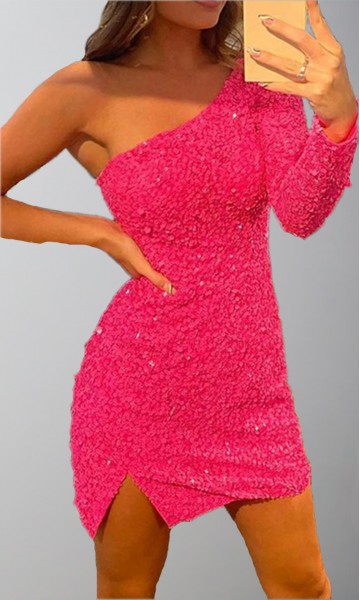Some modern brides prefer different wedding reception dresses. This two-dress trend allows the bride to change into a less formal gown to enjoy the reception party unencumbered by a traditional wedding dress.

Ceremony Versus Reception Dress Style
Although worn during the same wedding, a ceremony and reception dress usually have different attributes.
A ceremony dress might be more formal or have a fuller skirt; May have a long train; Can be more intricate in beading or other detail; May restrict a bride more in her movement; Can be more demure or covering to accommodate church or ceremony location rules; usually floor-length and more formal
A reception dress can be looser or more flowing, allowing for more movement; May be less structured; Has a short or no train, to allow for easier movement; Might be shorter in length, such as above the knee or tea-length; usually less formal; May not be white; May reflect the theme of the reception, such as the '50s, which would be inappropriate to display during the ceremony.
Formality Differences
The overarching difference between wedding gowns and wedding reception dress is their formality. A ceremony dress is often more formal so as to reflect the solemnity of the ceremony and church in which the ceremony occurs, while a reception dress is typically less structured and less formal to accommodate the party aspect of the wedding.
Gown Cost are not different
According to Glamour Weddings, there is no need for one of the two dresses to cost more or less than the other; instead, the two dresses can be relatively the same in terms of expense. However, the publication does state that, because the time spent in the reception dress is longer, you may consider spending slightly more on that dress.
Why Wear Reception Gowns
A bride wears a wedding reception dress for two main reasons: when she desires a second dress as personal choice or because of her culture's custom.
Personal Choice
Some brides make the personal choice to change dresses between the ceremony and reception. Reasons for this choice may be:
Falling in love with two wedding dresses and being unable to choose just one;
Having a family heirloom that is traditionally worn during the ceremony;
A dress being restrictive and better suited for a ceremony than dancing at a reception;
Wanting two wedding gowns
Regardless of reason, these brides change out of their ceremony dress and into their reception dress during the time between the two events.
Depending on the change, this may require alterations to her hair, makeup, and accessories.
Cultural Tradition
Some cultures have customs dictating that a bride should wear more than one outfit on her wedding day. Examples of these cultures include:
Japan: Japanese brides often wear more than one kimono on their wedding day. Traditionally, a simple kimono is worn during the ceremony and a more elaborate one during the reception.
China: Modern Chinese brides can change as many as three times during their wedding. Usually, the first outfit consists of a traditional white, Western dress worn during the civil ceremony. The second outfit, which is worn during the tea ceremony, consists of a traditional Chinese bridal gown. Finally, the bride changes a third time, usually into a cocktail dress, before the end of the reception banquet.
Morocco: Brides in this country can change their outfit as many as seven times during their wedding day. These outfit changes are more common amongst urban brides. The bride's wedding dress is usually a caftan, which is a long robe made of silk, satin or a similar fabric, covered with a jacket. However, most brides usually wear a white wedding gown after their final outfit change.
In multi-cultural weddings, it is not uncommon for a bride to change her gown between the ceremony and reception. One outfit will likely be the traditional outfit for her cultural background, such as an Indian wedding sari, but the other may be a contemporary Western long white gown. When to wear each item is up to the bride. For example, in an Indian-American wedding, some brides choose to wear the sari during the ceremony to reflect any traditional Indian elements included in it, while others prefer to wear the it during the reception so that they can move more freely while dancing.
Where to Find a Reception Dress
Although most bridal stores sell less formal gowns that are suitable for a reception dress, some larger department stores also sell gowns that are appropriate for a bride to wear during her wedding reception.
Happyprom
Happyprom offers lots of special occasion party dress to treat as reception-specific dresses, and stand out for their lack of formality and low cost. Many of these dresses are short, contain some color embellishment, and cost less than $200. For example, the Short Hot Pink Sequin Dress with one sleeve is knee-length and allows for easy movement due to side slit. This dress costs £98.00.

Additionally, the company offers prom gowns that are suitable to wear as wedding reception dresses. The Sequined Tulle Formal Dress contains a floor length skirt over a short dress and sells for £115.85. The dress' lack of formality and the fact that it exposes more of the bride's body than a traditional floor-length wedding gown make it perfect for a wedding reception.

Promboutiqueonline
Promboutiqueonlineis a website sells gorgeous wedding dresses, affordable bridesmaid dresses, elegant and cheap mother of the bride dresses online, also human hair wigs and shapewear for women.
The spotlight you should consider them as one of your shopping choice is their free custom made service, and the price. Choose one prom style dresses and custom made it into white color, you will open a new world.

Whether personal choice or cultural custom, purchasing and changing into a reception wedding dress allows you to showcase your background, personality, and style. You'll have the freedom to feel comfortable enough to dance the night away.



